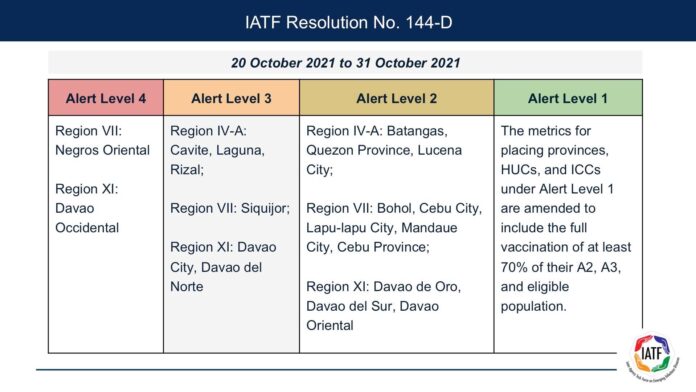-
Pilot testing of the alert level system will be expanded to 19 areas outside Metro Manila starting October 20 until October 31
-
If the alert level system proves effective, it will be implemented nationwide
-
The current community quarantine restrictions in other areas of the country will remain until October 31
The pilot testing of the alert level system in Metro Manila will be expanded to 19 provinces and cities starting October 20 to 31.
The Inter-Agency Task Force for the Management of Emerging Infectious Diseases (IATF) has approved expansion of the pilot implementation of the alert level system in the following areas:
- Alert Level 4: Negros Oriental and Davao Occidental
- Alert Level 3: Cavite, Laguna, Rizal, Siquijor, Davao City, and Davao del Norte
- Alert Level 2: Batangas, Quezon Province, Lucena City, Bohol, Cebu City, Lapu-Lapu City, Mandaue City, Cebu Province, Davao de Oro, Davao del Sur, and Davao Oriental
Metro Manila, which has been the pilot area for the alert level system since September 16, was earlier downgraded to Level 3 from Level 4 from October 16 to 31 as active COVID-19 cases have been on a decline.
The alert level system refers to the new community quarantine classifications for dealing with COVID-19, and covers entire cities, municipalities and/or regions with the aim to manage and minimize the risk of disease transmission through the use of system indicators, triggers, and thresholds determined by the IATF.
The government earlier said the objective of the pilot implementation is to assess if “granular” or small-scale lockdowns can more effectively reduce transmissions than wide-scale community quarantines, which are seen to be no longer effective.
Asked if the expansion of the covered areas meant the pilot implementation in Metro Manila was a success, presidential spokesperson Harry Roque, in a virtual media briefing on October 19, said the expansion to other areas is still part of the pilot study, but added that declining cases and improving healthcare utilization had something to do with the expansion of the implementation areas.
He noted, however, that the results of the initial implementation of the alert level system in Metro Manila are still being analyzed, and if it proves to be effective, the system will be implemented nationwide.
Under the guidelines, there are five alert levels:
- Alert Level 1 – areas where case transmission is low and decreasing, total bed utilization rate is low, and intensive care unit utilization rate is low
- Alert Level 2 – areas where case transmission is low and decreasing, healthcare utilization is low, or case counts are low but increasing, or case counts are low and decreasing but total bed utilization rate and intensive care unit utilization rate are increasing
- Alert Level 3 – areas where case counts are high and/or increasing, with total bed utilization rate and intensive care unit utilization rate increasing
- Alert Level 4 – areas where case counts are high and/or increasing, with total bed utilization rate and intensive care unit utilization rate at high levels
- Alert Level 5 – areas where case counts are alarming, with total bed utilization rate and intensive care unit utilization rate at critical levels
For Alert Level 5, establishments and/or activities characterized as high risk for transmission will not be allowed to operate.
For Alert Level 4, certain establishments or activities will be allowed to operate, or be undertaken at a maximum of 10% indoor venue capacity for fully vaccinated individuals only and 30% outdoor venue capacity provided that the businesses or activities have been issued a Safety Seal Certification.
For Level 3, certain establishments or activities will be allowed to operate, or be undertaken at a maximum of 30% indoor venue capacity for fully vaccinated individuals only and 50% outdoor venue capacity.
For Level 2, certain establishments, persons, or activities will be allowed to operate, work, or be undertaken at a maximum of 50% indoor venue capacity for fully vaccinated individuals only and those below 18 years of age, even if unvaccinated, and 70% outdoor venue capacity.
Certain business establishments in areas under Levels 3 and 2 that are awarded Safety Seal Certifications will be allowed to operate at an additional 10% beyond the prescribed on-site or venue/seating capacity, whichever is applicable.
Meanwhile, the current community quarantine restrictions in other areas in the country will remain until October 31.





